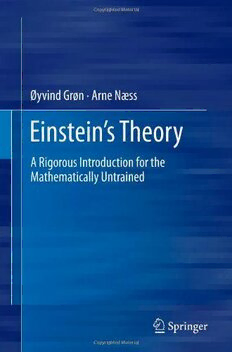
Einstein's Theory: A Rigorous Introduction for the Mathematically Untrained PDF
Preview Einstein's Theory: A Rigorous Introduction for the Mathematically Untrained
Einstein’s Theory Øyvind Grøn (cid:129) Arne Næss Einstein’s Theory A Rigorous Introduction for the Mathematically Untrained 123 ØyvindGrøn ArneNæss OsloUniversityCollege OsloUniversityCollege Oslo Oslo Norway Norway [email protected] ISBN978-1-4614-0705-8 e-ISBN978-1-4614-0706-5 DOI10.1007/978-1-4614-0706-5 SpringerNewYorkDordrechtHeidelbergLondon LibraryofCongressControlNumber:2011933475 ©SpringerScience+BusinessMedia,LLC2011 Allrightsreserved.Thisworkmaynotbetranslatedorcopiedinwholeorinpartwithoutthewritten permission of the publisher (Springer Science+Business Media, LLC, 233 Spring Street, New York, NY10013, USA),except forbrief excerpts inconnection with reviews orscholarly analysis. Usein connectionwithanyformofinformationstorageandretrieval,electronicadaptation,computersoftware, orbysimilarordissimilarmethodologynowknownorhereafterdevelopedisforbidden. Theuseinthispublicationoftradenames,trademarks,servicemarks,andsimilarterms,eveniftheyare notidentifiedassuch,isnottobetakenasanexpressionofopinionastowhetherornottheyaresubject toproprietaryrights. Printedonacid-freepaper SpringerispartofSpringerScience+BusinessMedia(www.springer.com) Preface by Arne Næss This introduction to The General Theory of Relativity and its mathematics is written for all those, young and old, who lack or have forgotten the necessary mathematical knowledge to cope with already published introductions. Some of theseintroductionsseem,atthestarttorequireonlymoderatelymuchmathematics. Verysoon,however,therearefrightful‘jumps’intheexposition,orsuddenlynew concepts or notations appear as if nearly self evident. The present text starts at a lowerlevelthananyother,andleadsthereaderslowlyandfaithfullyallthewayto theheartofrelativity:Einstein’sfieldequations. WhoarethosewhoseriouslydesiretogetacquaintedwithGeneralRelativity,but havepracticallynomathematicalknowledge?Therearetensofthousandsofthem, thankstothegreatgeneralinterestinrelativity,quantumphysicsandcosmologyof everyprofession,includingthosewitheducationonlyinthehumanities. Slowly many of these interested persons understand the truth of what one of the last Century’s most brilliant physicists and populariser,Sir Arthur Eddington, told us already in the 1920s: that strictly speaking, mathematical physics cannot beunderstoodthroughpopularisations.Mathematicsplaysarolethatisnotmerely instrumental, like cobalt chemicals for the paintings of Rembrandt. Mathematical conceptsenterinanessentialway,andreadersofpopularisationsaremislead.Their intelligence is insulted and bulled when they ask intelligent questions that their populartextcannotanswerexceptbyabsurdities.Thehonestreadersmayendupin aquagmireofparadoxes,andmaygettheusuallyfalseideathatthereissomething wrongwiththeirintelligence.Whattheyreadtheyconsiderbeyondtheirintellectual grasp. It is a widespread expectation that a mathematical understanding of general relativity involves difficult calculations. Actually, coping with the few somewhat lengthystringsofsymbolsinthistextmaybefeltasarelieffromabstractthinking. Whattakestimeisthethoroughunderstandingoftherelationsbetweenafewbasic concepts. They require close, repeated attention and patient work. This surprising featureto somedegreejustifies thatwe havenotincludedexercisesinthe text.To v vi PrefacebyArneNæss be honest, some should have been included,but they would have been of a rather strangekind:exercisesinarticulatingconceptualrelations. But what about the formidable calculations one may read about in popularisa- tions? Theyaffectapplications,forinstance particularsolutionsof Einstein’sfield equations. Examples of such calculations are found in appendicesB and C. Even if the reader should not expect to be an operator of relativistic physics, he or she shouldbewellacquaintedwithithavingreadthisbook.Weventuretosuggestthat theunderstandingacquiredbythereadermaybedeeperthanwhatisnecessaryfor completinggraduatecoursesintendedtomakethestudentanexpertincalculations involvinggeneralrelativity,butrequiringonlycrudediscussionsoftheall-important conceptualframework. Thepresenttextshows,wehope,thatonlypatienceisneeded—nospecialtalent for mathematics. Personally I have never shown any such talent, only a persistent wonderatstrangemathematicalphenomena,liketheendlessnumber3.1415...with theveryshortname‘pi’.(Caution:thelengthofthecircumferenceofacircledivided by the diameter may have any value. Only in the special case of a flat space will you get the number 3.1415.... More about that later!) Again and again I refused to comply with the long streams of strange mathematical symbols which Øyvind Grøn,mypatientGuruof mathematicsandphysics,rapidlywrote onour gigantic blackboard.“Stop, stop! I don’twant that equation! How did you jump from that onetothe next?”To theastonishmentofbothofusitwaspossibleto breakdown thelongdeductionsintosmallandeasilyunderstandablesteps. A seriousweaknessof those courses,in myview asa humanist,is the implicit appealto makethestudentacceptwhatisgoingonwithoutwondering.Alongthe road to Einstein’s field equations,feats of artistic conceptualimaginationabound. Also postulates and assumptions of seemingly arbitrary kinds are made. Some of them are seen to have a rational aspect when properly understood, but far from all. Einstein did not find all this wonderful. What deeply moved him in his wonder was that the concepts and equations he (and others, like Minkowski) invented, could be tested in the real world and in part confirmed. Somehow there mustbe,wonderedEinstein,akindof‘pre-establishedharmony’betweeninventive conceptualimaginationandaspectsofrealityitself. Thepresenttexttriestokeepwonderalive,awondernotduetomisunderstandings. Some people,as partof their religion,creep on their kneesall aroundthe holy mountain Kailas in Tibet. The present text would not have been produced if it had not been clearly felt as a way of honouring Albert Einstein not only as a persistent, fully committed truth seeker, but as a person combining this, and the ‘egocentricity’goingwithit,withperfectgenerosity.Heusedhisnameandhistime toworkforthepersecuted,foremigrants,forthehungry.And,inaddition,feeling theabsurdityofthepoliticaldevelopments,hepartookindepressingworldaffairs, even compromisinghis deeply felt pacifism. And, last but not least, he retained a sense of humour,andeven as a superstar,was unawareof his outerappearanceto theextentofneglectingtokeephisworntrousersproperlyshutwhenlecturing.He would perhaps laugh if he got to know that this text is an expression of personal devotion. Preface by Øyvind Grøn One day, early in the Autumn 1985, the seventy three year old philosopher Arne Næssappearedatmygraduatecourseongeneralrelativity.Heimmediatlydecided that a new type of introduction to the general theory of relativity is needed; an introduction designed to meet the requirements of non-science educated people wantingtogetathoroughunderstandingofthis,mostremarkable,theory. The present text is the result of our efforts to provide a useful book for these people.It is neithera popularnora semi-popularaccountof the theory.The book requiresa rather large amountof patience from the reader,but nearly no previous knowledgeofphysicsandmathematics.Ourintentionistogiveanintroductionthat leadsrightuptoEinstein’sfieldequationsandtheirmostimportantconsequences, starting at a lower level than what is common. The mathematical deductions are madewithsmallstepssothatthemathematicallyinexperiencedreadermayfollow whathappens.Themeaningoftheconceptsthatappearareexplainedandillustrated. Andinsomeinstanceswementionpointsofamorephilosophicalcharacter. We devote a whole chapter to each of the topics ‘vectors’, ‘differentiation’, ‘curves’ and ‘curved coordinate systems’. Tensors are indispensable tools in a formulation of the general theory of relativity intended to give the reader the possibilitytoapplythetheory,atleasttosomesimple,butnonethelessnon-trivial, problems.Themetrictensorisintroducedinchapter5,whichalsoprovidesamost importantdiscussionofthekinematicinterpretationofthespacetimelineelement. Albert Einstein demanded from his theory that no coordinate system is priv- ileged. And in general curved coordinate systems are needed to describe curved spaces.Insuchcoordinatesystemsthebasisvectorsvarywiththeposition.Thisis describedbytheChristoffelsymbols.Inchapter6wegiveathoroughdiscussion,of a geometricalcharacter,showinghow the basis vectorsof planepolar coordinates change with position, and relate this to the Christoffel symbols. Having worked yourselfthroughthischapter,itisourhopethatyouhaveobtainedahighdegreeof familiaritywiththeChristoffelsymbols. ‘Covariantdifferentiation’,‘geodesiccurves’and‘curvature’areimportanttop- icsforminga‘package’ofprerequisitesnecessaryinordertobeabletoappreciate vii viii PrefacebyØyvindGrøn fullyEinstein’sgeometricconceptionofgravity.Thesetopicsaretreatedinchapters 7,8and9,respectively.TheexpressionfortheRiemanncurvaturetensorisdeduced byutilisingGreen’stheoremconnectingcirculationandcurl. Einstein’slawofgravitationisformulatedmathematicallyinhisfieldequations. Theytellhow mattercurvesspacetime. Thefield equationsrequirean appropriate tensor representation of some properties of matter, i.e. of density, stress and motion.Theusualrepresentationofthese propertiesismotivatedandexplainedin chapter 10, where the basic conservation laws of classical fluid mechanics are expressedintensorform.Inchapter11theexpressionforEinstein’sdivergencefree curvaturetensorisdeduced.Withthischapterourpreparationforapresentationof generalrelativityhasbeenfulfilled. Einstein’s general theory of relativity is presented in chapter 12. Here we discusstheconceptualcontentsofthegeneraltheoryofrelativity.Weconsiderthe Newtonian limit of the theory, and we give an elementary demonstration of the followingtheorem:Fromthegeneraltheoryofrelativityandtheassumptionthatit isimpossibletomeasurevelocityrelativetovacuum,itfollowsthatvacuumenergy actsuponitselfwithrepulsivegravitation. Inchapters13and14wededucesomeconsequencesofthetheory.Inparticular we discuss the gravitational time dilation, the deflection of light, the relativistic contributiontoMercury’sperihelionprecession,andwegiveadetailedexplanation of how the theory predicts the possible existence of black holes. Finally the most importantrelativisticuniversemodels,includingtheso-calledinflationaryuniverse models,arediscussed. Detailed calculations of the form of the Laplacian differential operator in spherical coordinates, needed in chapter 12, and of the components of the Ricci curvaturetensor,neededtowritedownEinstein’sfieldequationsfortheapplications inchapters13and14,arepresentedinappendicesA,B,andC,respectively. Looking at the stars with Einstein’s theory in mind, you may feel it is like a wonderthatEinsteinmanagedtorevealsuchdeepsecretsofcosmostous.People doinfactsearchforblackholesnow.Andtherearestrongindicationsthatatleasta fewhavebeenfound.Whatmysteriousconnectionistherethatmakesnature‘obey’ Einstein’sgreatmentalconstruction-thegeneraltheoryofrelativity? Acknowledgements The authors would like to thank Henning R. Bra˚ten, Jon M. Bjerkholt, Trond Bjerkholt, Jan Frøyland and Henning Knutsen for being our first readers and for givingseveralusefulsuggestionsofapedagogicalcharacter. MostofthisbookwaswritteninthehomeofKitFaiandArne.Wewanttothank Kit Fai for opening her and Arne’s home for us in a very friendly manner which contributedmuchtothepleasurewehadintheprocessofwritingthisbook. JanFrøyland HenningKnutsen HaraldSoleng JonDøhl ix
